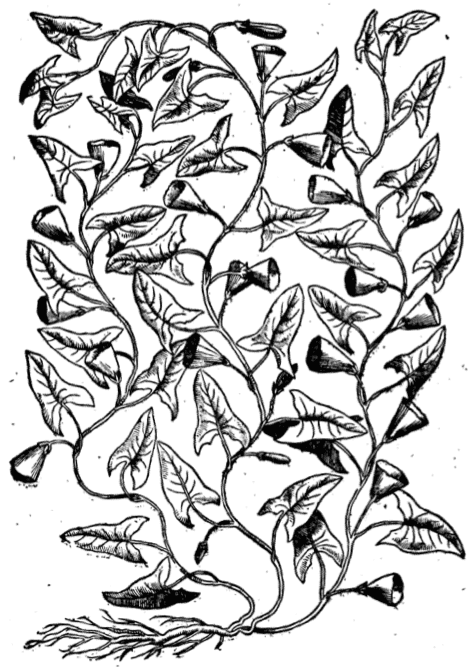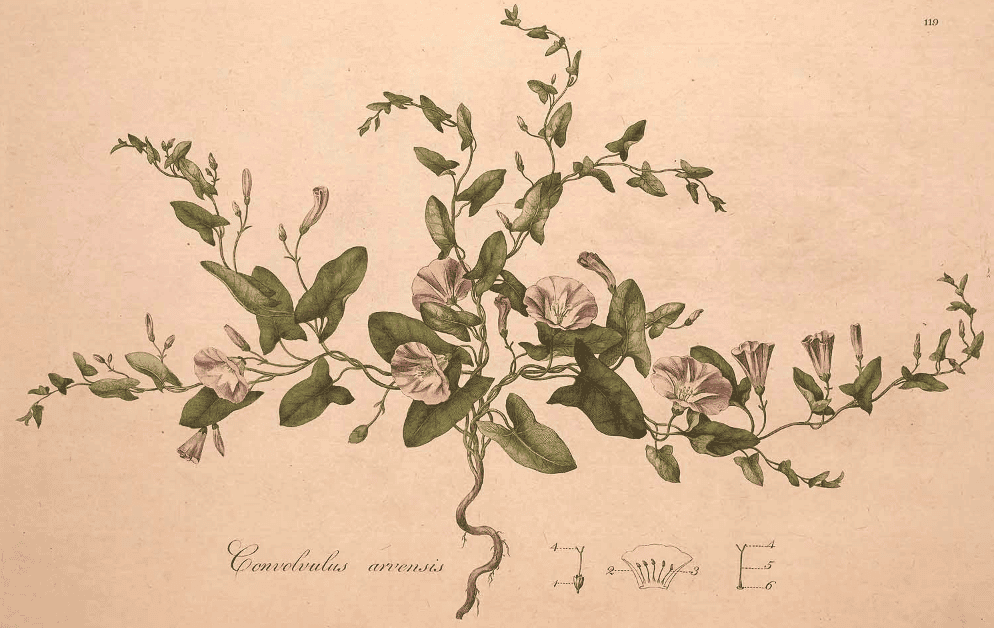Convolvulus, BindweedGreater Bindweed, Helxine, VolubilisTian Xuan Hua (TCM) |

|
 Convolvulus arvensis, Field Bindweed
Convolvulus arvensis, Field BindweedNew Kreuterbuch, Matthiolus, 1563
 Curtis, William, Flora Londinensis, vol. 2 (1777-1778)
Curtis, William, Flora Londinensis, vol. 2 (1777-1778)Botanical name:
Convolvulus spp.
Several varieties were known:
1. Common Bindweed: C. alba
2. Greater or Hedge Bindweed: C. sepium
3. Lesser Bindweed: C. minor
4. Field Bindweed: C. arvensis
5.. Hedge Bindweed: C spp.
6.. Sea Bindweed: C. Soldanella
The Common and Field Bindweeds were most commonly used.
Parts used:
Root, Whole plant in Flower, Juice (topically)
Temperature & Taste:
Warm, dry. Toxic
Classifications:
Vulnerary, Arthritic, Purgative
Uses:
1. Clears Phlegm, Resists Poison, Resolves Masses:
-Scrofula, Tumors, Cancer
-used internally and topically for Tumors, ‘Running Sores and Ulcers’, Foul Ulcers, Fistulas
2. Purges Phlegm and Bile:
-Constipation
-good to purge Cold Phlegm and crude Humors
-Liver congestion
-Fever
3. Externally:
-juice with wine as a mouth wash for sores in the Mouth, Thrush and Canker in children
-juice with wine or cataplasm is applied to Chilblains
-a little of the juice sniffed up the nose for Running Sores or Ulcers of the nose
-used as a Wound herb
-applied to waste Tumors and Scrofula (Ointment, Cataplasm, Balsam)
-herb is applied to Wind-Damp pain of the joints and muscles (TCM)
-herb and flower are applied to Neurodermatitis and Itchiness in TCM.
-applied to redness and itchiness of the nails (Hildegard)
-powdered root or thickened juice mixed with wine to wash old Sores, Foul and Running Ulcers and Fistulas, causing speedy cure. (Salmon)
-distilled water of the herb is a good cosmetic, clears Pimples, Eczema, removes Freckles, redness of the face or skin, Sunburn etc., especially if mixed with Vinegar
Dose:
Most used externally. Used internally, lesser doses should be begun with.
Of the root in Decoction or long Infusion: 2–5 grams; Of the Powder: 500–1500mg
Comment:
1. Salmon noted ‘It is peculiar for wasting and discussing Tumors’ (Botanologia, 1710)
2. Salmon also noted that it is closely allied to Scammony in appearance and function, but is much less energetic. However, varying species and different climate can increase the strength.
3. Should not be confused with Sarsaparilla which was called Prickly Bindweed.
4. The herb and flower of C. arvensis are used (though rarely) in TCM, and are called Tian Xuan Hua. It clears Wind, stops Itch and eases Pain, and is principally used for Wind-Damp pain, Neurodermatitis, Itchiness and Toothache
Main Combinations:
1. Pimples, Freckles, Spots, Sunburn, Redness of the skin, use the distilled water of the herb with Niter as a wash
Cautions:
1. Avoid in Pregnancy
2. Due to irritant resin, overdose should be avoided. Used internally, lesser doses should be begun with.
Main Preparations used:
Salmon,
Botanologia, 1710:
‘It admirable cleanses and heals old, rotten, and stinking Ulcers: and where the Bone has been putrified, it has perfectly cleansed the Ulcer, dried the Bone, and in a little time scaled it, and afterwards by the continual application, it has covered it with flesh, incarnated the Ulcer, and in a little time healed it: I speak this by a great experience: One time it happened, that a Youth who had Kibes on his feet, and so much corrupted, that the Bone itself was putrified; by the sole application of this powder, dry, upon the Ulcer, I cleansed it, scaled the Bone which was black, afterwards incarnated and healed the Ulcer, beyond the expectation of any one that saw it’.
